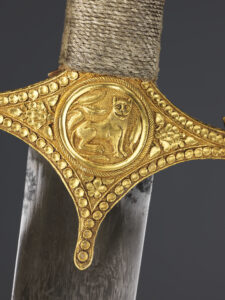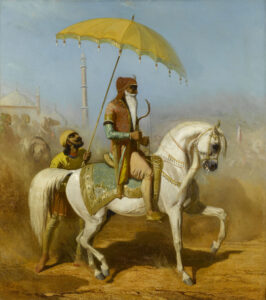Exhibition Highlights – Ranjit Singh: Sikh, Warrior, King at the Wallace Collection
Forged of watered steel, ornamented with walrus ivory, precious metals and pearl, and accompanied by a scabbard of gold and rubies, this remarkable shamshir, also known as a scimitar, was acquired in Paris by the 4th Marquess of Hertford (1800–1870).
The sword’s magnificence reflects the prestige of its owner. At the Musée rétrospectif exhibition in 1865, it was described as having belonged to ‘Runjet Sing’ himself. At the centre of the cross guard sits a golden tiger, a fitting emblem for the fearless warrior whose names translates as ‘Battle-victory Tiger’.

Sword associated with Maharaja Ranjit Singh, Awadh, late 18th/early 19th century. The Wallace
A natural horseman from childhood, Ranjit Singh nurtured a well-documented love of horses. His lavish stable of Arabian thoroughbreds was so renowned that it inspired the common saying that the price of the entire city of Lahore was equal to the cost of the maharaja’s horses. In 1830, this equine obsession sparked a full-scale war to obtain the legendary horse Asp-i-Laili (Black Horse) from an Afghan overlord.
This painting by the celebrated French equestrian artist Alfred Dedreux (1810–1860) was commissioned by General Ventura (1794–1858), a leading Italian officer in Sikh service, while he was on leave in France in 1838. The work draws inspiration from a miniature painting by Imam Bakhsh Lahori (active c. 1825–45), which also features in the exhibition, and subtly reflects the Gallic influence at the Sikh court through the presence of a tricolour. It was later presented to King Louis Philippe I (1773–1850) as a mark of friendship between the two states.

Collection, OA1404 Alfred Dedreux, Randjiit Sing Baadour, Roi de Lahore (Ranjit Singh the Brave, King of Lahore), commissioned by General Ventura, Paris, c. 1837. Musée du Louvre © RMN-Grand Palais (musée du Louvre) / Stéphane Maréchalle





